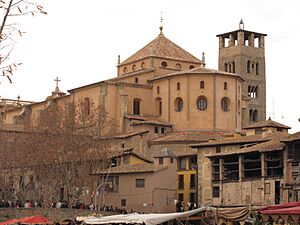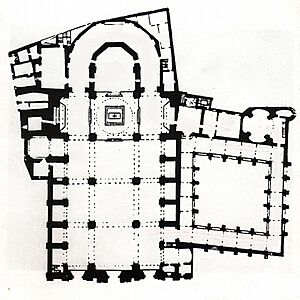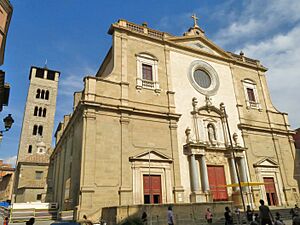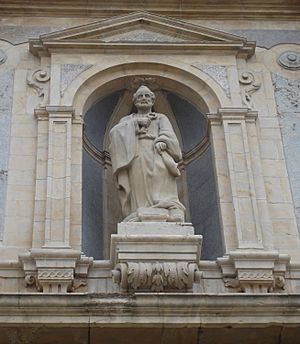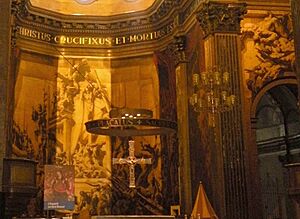Vic Cathedral facts for kids
Quick facts for kids Vic Cathedral |
|
|---|---|
| Cathedral of St. Peter of Vic | |
|
Catalan: Catedral de Vic
|
|
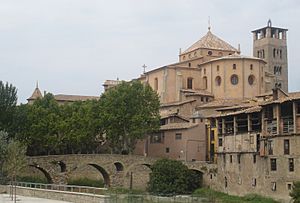
Vic Cathedral seen from the river
|
|
| Lua error in Module:Location_map at line 416: Malformed coordinates value. | |
| Lua error in Module:Coordinates at line 614: attempt to index field 'wikibase' (a nil value). | |
| Location | Vic, Catalonia |
| Country | Spain |
| Denomination | Roman Catholic |
| History | |
| Status | Cathedral, minor basilica |
| Consecrated | 1038 and September 15, 1803 |
| Architecture | |
| Architect(s) | Josep Moretó i Codina |
| Architectural type | Church |
| Style | Romanesque, Gothic, Neoclassical |
| Groundbreaking | September 24, 1781 |
| Completed | 1803 |
| Specifications | |
| Materials | Marble, brick |
| Administration | |
| Archdiocese | Roman Catholic Diocese of Vic |
The Vic Cathedral (called Catedral de Vic in Catalan) is a large Roman Catholic church in Vic, Catalonia, Spain. It is also known as the Cathedral of St. Peter the Apostle. This important building is the main church for the Diocese of Vic.
The cathedral shows a mix of different building styles. You can see parts that are Romanesque, Gothic, Baroque, and Neoclassic. This mix of styles tells the story of its long history.
Contents
History of Vic Cathedral
Early Beginnings
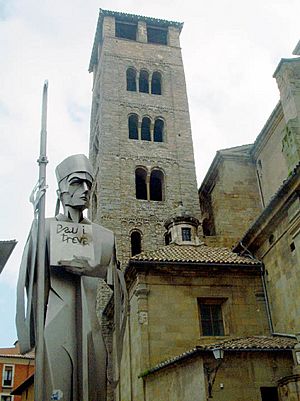
We don't know exactly where the very first church in Vic stood. But records show a cathedral existed in Vic as early as the year 516. This early church was likely destroyed around 717-718 during the Arab invasion.
Later, in 886, a leader named Wilfred the Hairy helped rebuild the area. A simple church was built then. In the 10th century, as the Christian area became safer, the cathedral was rebuilt again. This time, it was made of stone and had three main sections.
The Cathedral of Abat Oliba
About a hundred years later, a bishop named Abat Oliba rebuilt the cathedral once more. He made it in a grand Romanesque style. It was officially opened in 1038.
The bell tower, which is 46 meters (about 150 feet) tall, was built separately from the main church. Today, only this bell tower and the crypt (an underground room) remain from Oliba's time. The crypt is special because it has old stone carvings from the 10th-century church. You can also see some Romanesque art from the old entrance and cloister at the Episcopal Museum of Vic.
Two hundred years later, the cathedral needed repairs. In the 1300s, a beautiful upper cloister (a covered walkway around a courtyard) was added. Also, a main altarpiece made of alabaster was finished in 1428. These parts are still visible today. In 1401, a cross-shaped section called a transept was added.
Santa Maria la Rodona Church
For many centuries, there was another important church next to the cathedral called Santa Maria la Rodona. It was unusual because it was round! Bishops would hold special services there. This church was rebuilt several times. The last version was finished in 1140.
However, in 1787, this round church was taken down. This was done to make space for the new cathedral that was being planned. Today, you can see marks on the ground in the Cathedral Square where its foundations used to be.
The Current Cathedral Building
The construction of the new cathedral began on September 24, 1781. It was officially opened on September 15, 1803. The design was created by Josep Moretó i Codina, an architect from Vic. He designed it in a Neoclassical style, which was popular at the time.
In 1891, the Episcopal Museum of Vic opened on the upper floor of the cathedral's cloister.
The 19th century was a difficult time for the cathedral. In the 20th century, a famous Catalan painter named Josep Maria Sert was asked to paint the large, empty walls inside. He finished his first set of paintings in 1930. In 1931, the cathedral was recognized as a Historic Artistic Monument.
Sadly, in 1936, at the start of the Spanish Civil War, the cathedral was badly damaged by fire. Most of Sert's paintings were destroyed, and parts of the ceiling collapsed. After the war, repair work began. Sert repainted the walls, and the church reopened in 1945.
Architecture and Art
The current cathedral has a serious and formal Neoclassical look. Its white stone front has columns and a decorative railing. The front of the cathedral, built in 1803, features a round window at the top. It has three entrances, one for each of its three main sections. The central entrance is the most decorated, with columns and a sculpture of Saint Peter, who is the patron saint of the church.
Some experts think the building's design is not perfectly balanced. They find its decorations a bit plain.
Inside the Cathedral
Inside, the cathedral has three main sections, all the same height. These sections are separated by tall columns. It also has a large transept (the part that crosses the main section), a rounded ceiling, and a dome in the center. The side sections have two chapels under each arch.
Paintings by Josep Maria Sert
In the early 1900s, the Catalan painter Josep Maria Sert was chosen to decorate the huge white walls inside the cathedral. He worked on these paintings between 1926 and 1930. These were large oil paintings placed on the walls.
As mentioned, the 1936 fire destroyed most of Sert's first work. After the war, between 1939 and 1945, Josep Maria Sert created new paintings for the cathedral. He passed away before finishing the very last ones, so his students completed them in his style. The second set of paintings is generally less colorful than the first.
Sert's paintings are huge canvases on the cathedral walls. They show his unique style, with strong, large figures and dramatic contrasts between light and shadow. They are mostly in gold, brown, and orange colors, with some red. This use of color and volume creates a feeling of great depth.
The paintings tell stories from the Bible, focusing on the idea of redemption. For example, in the rounded end of the church, you can see scenes of Jesus's crucifixion, burial, and ascension. Other walls show stories like Adam and Eve's fall and the martyrdom (suffering) of apostles.
Main Altarpiece
The main altarpiece is a large, decorated screen behind the altar. It is made of alabaster and was created between 1420 and 1427 by Pere Oller. It is dedicated to the Virgin Mary and Saint Peter.
Chapels
On the north side of the cathedral, there are several chapels built in the Baroque style. These were part of a plan from the early 1600s for a new cathedral.
One important chapel is the chapel of Sant Bernat Calbó, located under the bell tower. It was built in 1633. Saint Bernat Calbó was a bishop of Vic from 1233 to 1243. His body rests in a large silver box made between 1700 and 1728.
In the chapel of the Virgin of Montserrat, you can find the tomb of Bishop Josep Torras i Bages. There is also a sculpture of a dead Christ by Josep Llimona i Bruguera.
The Crypt
The crypt is an underground room that dates back to the Romanesque cathedral. This part of the church was opened in 1038. The stone carvings on the columns in the crypt are even older. They were reused from the earlier pre-Romanesque cathedral.
The Cloister
The cathedral has a beautiful cloister, which is a covered walkway around a courtyard. It has two levels. The lower level is Romanesque and from the 12th century. The upper level is Gothic and was built in the 14th century. This cloister is special because it has double windows that look both into the courtyard and out towards the city. It also has a Gothic door leading to the chapter room.
The lower cloister connects to the chapter room, which was opened in 1360. This room has a rectangular shape with an eight-sided ceiling. In the center of the cloister, you will find the tomb of Jaume Balmes, a famous Catalan philosopher from Vic. His statue, made in 1853, was moved to the cloister in 1865.
See also
 In Spanish: Catedral de San Pedro (Vic) para niños
In Spanish: Catedral de San Pedro (Vic) para niños
- Josep Maria Sert


